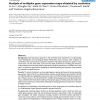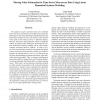IJCNN
2008
IEEE
14 years 5 months ago
2008
IEEE
— Gene expression based cancer classification using classifier ensembles is the main focus of this work. A new ensemble method is proposed that combines predictions of a small ...
ECCB
2008
IEEE
14 years 6 months ago
2008
IEEE
Living cells are the product of gene expression programs that involve the regulated transcription of thousands of genes. The elucidation of transcriptional regulatory networks in ...
BIBM
2008
IEEE
14 years 6 months ago
2008
IEEE
Background: Gene expression signatures in the mammalian brain hold the key to understanding neural development and neurological disease. Researchers have previously used voxelatio...
AINA
2008
IEEE
14 years 6 months ago
2008
IEEE
The analysis of gene expression time series obtained from microarray experiments can be effectively exploited to understand a wide range of biological phenomena from the homeostat...
ADMA
2009
Springer
14 years 6 months ago
2009
Springer
It is of high biomedical interest to identify gene interactions and networks that are associated with developmental and physiological functions in the mouse embryo. There are now v...
ACML
2009
Springer
14 years 6 months ago
2009
Springer
Abstract. In experimental design, a standard approach for distinguishing experimentally induced effects from unwanted effects is to design control measurements that differ only ...
ISBRA
2009
Springer
14 years 6 months ago
2009
Springer
Identifying gene regulatory networks from high-throughput gene expression data is one of the most important goals of bioinformatics, but it remains difficult to define what makes a...
ACSC
2009
IEEE
14 years 6 months ago
2009
IEEE
In this paper we aim to infer a model of genetic networks from time series data of gene expression profiles by using a new gene expression programming algorithm. Gene expression n...
RECOMB
2006
Springer
14 years 11 months ago
2006
Springer
MicroRNAs (miRNAs) have recently been discovered as an important class of non-coding RNA genes that play a major role in regulating gene expression, providing a means to control th...
RECOMB
2007
Springer
14 years 11 months ago
2007
Springer
Determining the precise spatial extent of expression of genes across different tissues, along with knowledge of the biochemical function of the genes is critical for understanding ...



